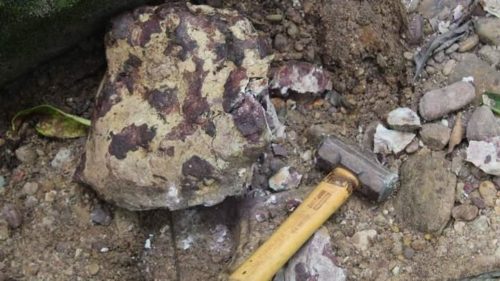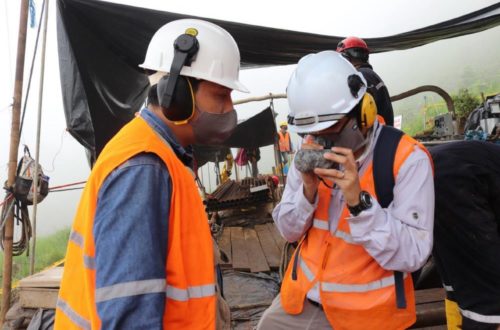
Karora Resources Reports New Fletcher South Infill Drill Program Results Building Confidence in Continuity of Mineralization
Fletcher Highlights1
• WF405SOD-51AE: 2.8 g/t over 52.0 metres and 11.8 g/t over 2.9 metres
• WF405SOD-01AE: 3.3 g/t over 9.0 metres and 2.5 g/t over 10.5 metres
• BF1730-22AE: 3.1 g/t over 13.0 metres, 3.8 g/t over 9.0 metres and 2.5 g/t over 17.0 metres
• WF405SOD-52AE: 4.7 g/t over 11.0 metres
1. Interval lengths are downhole widths. Estimated true widths cannot be determined with available information.
Paul Andre Huet, Chairman & CEO, commented: "Today we reported more strong results from the Beta Hunt drilling program in our Fletcher South Zone. Our results returned strong gold mineralization over very long intercepts, including 2.8 g/t over 52 metres. We also identified new parallel mineralized lodes in the footwall of the FSZ, including results of 4.7 g/t over 11.0 metres and 3.8 g/t over 9.0 metres.
To date we have completed eight of nine planned infill drill holes targeting a 500 metre strike length of the Fletcher South Zone just north of our strong results reported in April (6.5 g/t over 26.0 metres and 46.5 g/t over 7.0 metres in hole BL1730-04AE – see Karora news release, April 13, 2023). The results are very encouraging, demonstrating mineralization continues along the Fletcher Shear Zone, as targeted, as well as parallel mineralized lodes. This once again illustrates the significant potential for ongoing discoveries as we continue to deploy capital into our Beta Hunt drilling program. Assays from the five remaining holes are expected to be received during the third quarter and we await their results eagerly.
As we have stated numerous times, Beta Hunt is a very large system which was underexplored historically due to cumbersome royalty burdens. As we continue to drill out our targets with those royalty burdens significantly reduced, we have been rewarded with many new shear zones and new Mineral Resource additions to our inventory each year. Beta Hunt’s next resource estimate will be released in the fourth quarter.”
Fletcher Exploration Drilling Update
Background
The gold mineralized Fletcher Shear Zone (FSZ) is considered a structural analogue to the Western Flanks and A Zone deposits, representing Beta Hunt’s third major mineralized shear zone system in the Hunt Block. The FSZ comprises foliated biotite-pyrite altered and irregularly quartz veined basalt – similar alteration to that found at Western Flanks. Previously reported drilling results (Figure 1) outlined a steep, west-dipping zone over 150 metres in down dip extent and over 500 metres of strike with potential to extend over a total strike length of 2 kilometres (See Karora news releases dated September 16, 2019; January 24, 2022; May 24, 2022).
In April 2023 Karora intersected significant, high-grade mineralization in a single hole (BL1730-04AE) drilled from the south side of the AIF through the fault to test for the interpreted southern extension of the FSZ, north of the AIF. This hole intersected strong mineralization over two intervals in the targeted position for FSZ mineralization. This result represented the widest and highest grade ever intersected for the FSZ (see Karora news release April 13, 2023). Significant intersections1. previously reported from this hole are highlighted below:
• BL1730-04AE (Interval 1): 6.5 g/t over 26.0 metres, including:
o 9.9 g/t over 6.0 metres
o 6.5 g/t over 17.0 metres
• BL1730-04AE (Interval 2): 46.5 g/t over 7.0 metres, including 262 g/t over 0.7 metres
1. Interval lengths are downhole widths. Estimated true widths cannot be determined with available information.
5,000 metre Fletcher Infill Drill Program
A nine hole follow up, 5,000 metre diamond drill program was designed to test and infill the southern end of the FSZ over a 500 metre strike length with holes spaced on a nominal 120 metre X 80 metre grid. The program commenced in June 2023 with eight of the nine holes completed to date.
Assay results have now been received for four of the nine holes. All four holes have encountered significant mineralization in the targeted FSZ position with additional mineralization intersected in between the Western Flanks and the FSZ indicating potential for a number of parallel mineralized lodes in the footwall to the FSZ (Figures 1). Additional mineralization is also encountered in the hanging wall of the FSZ. Significant intersections1. received to date are highlighted below:
• WF405SOD-01AE:
o FSZ: 2.5 g/t over 10.5 metres
o Footwall Zone: 3.3 g/t over 9.0 metres
• WF405SOD-51AE:
o FSZ: 2.8 g/t over 52.0 metres, including 8.5 g/t over 3.0 metres
o Hanging wall Zone: 11.8 g/t over 2.9 metres and 7.1 g/t over 3.5 metres
• BF1730-22AE:
o FSZ: 3.1 g/t over 13.0 metres and 3.8 g/t over 9.0 metres
o Footwall Lode: 2.5 g/t over 17.0 metres
• WF405SOD-52AE:
o FSZ: 2.2 g/t over 13.0 metres
o Footwall Lode: 4.7 g/t over 11.0 metres
These most recent drill assays have reinforced the FSZ as a strong gold mineralized system with potential to develop into another Western Flanks. Results to date show the predicted target position of the FSZ to be supported by strong gold intersections providing a high level of confidence in the continuity of the mineralization. Preliminary interpretation of the southern end shows the main FSZ to vary from 10 metres to 50 metres in downhole widths. In addition to the FSZ, multiple mineralized shear zones associated with the characteristic biotite-pyrite alteration have been intersected in the hanging wall and footwall positions to the FSZ. These present additional mining opportunities as part of any potential mine development west of the Western Flanks.
Additional key points:
• The Fletcher South drilling covers only 25% of the of the interpreted 2km strike of the FSZ, highlighting the significant growth potential of this mineralized system.
• The reported intersections are 230 metres from existing nickel development in the Beta Block and 150 metres north of the current Larkin Mineral Reserve, presenting opportunities for using existing and planned development to access the FSZ.
• The nickel potential associated with the interpreted trough position above the FSZ has yet to be fully tested. As is frequently practiced at Beta Hunt, testing for nickel can be executed concurrently with further gold exploration.
Final assays from this program are expected to be received during Q3. The results will be assessed for the potential to be converted into a new Mineral Resource in the FSZ.
Compliance Statement (JORC 2012 and NI 43-101)
The disclosure of scientific and technical information contained in this news release has been reviewed and approved by Stephen Devlin, FAusIMM, Group Geologist, Karora Resources Inc., a Qualified Person for the purposes of NI 43-101.
At Beta Hunt all drill core sampling is conducted by Karora personnel. Samples for gold analysis are shipped to SGS Mineral Services of Kalgoorlie for preparation and assaying by 50 gram fire assay analytical method. All gold diamond drilling samples submitted for assay include at least one blank and one Certified Reference Material ("CRM") per batch, plus one CRM or blank every 20 samples. In samples with observed visible gold mineralization, a coarse blank is inserted after the visible gold mineralization to serve as both a coarse flush to prevent contamination of subsequent samples and a test for gold smearing from one sample to the next which may have resulted from inadequate cleaning of the crusher and pulveriser. The lab is also required to undertake a minimum of 1 in 20 wet screens on pulverised samples to ensure a minimum 90% passing at -75µm. Samples for nickel analysis are shipped to SGS Australia Mineral Services of Kalgoorlie for preparation. Pulps are then shipped to Perth for assaying. The analytical technique is ICP41Q, a four acid digest ICP-AES package. Assays recorded above the upper detection limit (25,000ppm Ni) are re-analyzed using the same technique with a greater dilution (ICP43B). All samples submitted for nickel assay include at least one Certified Reference Material (CRM) per batch, with a minimum of one CRM per 20 samples. Where problems have been identified in QAQC checks, Karora personnel and the SGS laboratory staff have actively pursued and corrected the issues as standard procedure.
About Karora Resources
Karora is focused on increasing gold production to a targeted range of 170,000-195,000 ounces by 2024 at its integrated Beta Hunt Gold Mine and Higginsville Gold Operations ("HGO") in Western Australia. The Higginsville treatment facility is a low-cost 1.6 Mtpa processing plant, which is fed at capacity from Karora’s underground Beta Hunt mine and Higginsville mines. In July 2022, Karora acquired the 1.0 Mtpa Lakewood Mill in Western Australia. At Beta Hunt, a robust gold Mineral Resource and Reserve are hosted in multiple gold shears, with gold intersections along a 5 km strike length remaining open in multiple directions. HGO has a substantial Mineral gold Resource and Reserve and prospective land package totaling approximately 1,900 square kilometers. Karora has a strong Board and management team focused on delivering shareholder value and responsible mining, as demonstrated by Karora’s commitment to reducing emissions across its operations. Karora’s common shares trade on the TSX under the symbol KRR and on the OTCQX market under the symbol KRRGF.
Cautionary Statement Concerning Forward-Looking Statements
This news release contains "forward-looking information" including without limitation statements relating to, among other items, production guidance, timing for completion of capital projects, timing for the commencement of mining, liquidity and capital resources of Karora, organic growth profile and the potential of the Beta Hunt Mine, Higginsville Gold Operation, the Aquarius and Two Boys Projects, Spargos Gold Mine and Lake Cowan prospect.
Forward-looking statements involve known and unknown risks, uncertainties and other factors which may cause the actual results, performance or achievements of Karora to be materially different from any future results, performance or achievements expressed or implied by the forward-looking statements. Factors that could affect the outcome include, among others: future prices and the supply of metals; the results of drilling; inability to raise the money necessary to incur the expenditures required to retain and advance the properties; environmental liabilities (known and unknown); general business, economic, competitive, political and social uncertainties; results of exploration programs; accidents, labour disputes and other risks of the mining industry; political instability, terrorism, insurrection or war; or delays in obtaining governmental approvals, projected cash operating costs, failure to obtain regulatory or shareholder approvals. For a more detailed discussion of such risks and other factors that could cause actual results to differ materially from those expressed or implied by such forwardlooking statements, refer to Karora ’s filings with Canadian securities regulators, including the most recent Annual Information Form, available on SEDAR at www.sedar.com.
Although Karora has attempted to identify important factors that could cause actual actions, events or results to differ materially from those described in forward-looking statements, there may be other factors that cause actions, events or results to differ from those anticipated, estimated or intended. Forward-looking statements contained herein are made as of the date of this news release and Karora disclaims any obligation to update any forward-looking statements, whether as a result of new information, future events or results or otherwise, except as required by applicable securities laws.
Swiss Resource Capital AG
Poststrasse 1
CH9100 Herisau
Telefon: +41 (71) 354-8501
Telefax: +41 (71) 560-4271
http://www.resource-capital.ch
CEO
Telefon: +41 (71) 3548501
E-Mail: js@resource-capital.ch
Telefon: +41 (71) 354-8501
E-Mail: mo@resource-capital.ch
![]()



